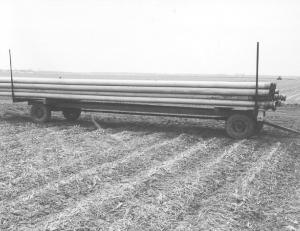2000 - Volume #24, Issue #4, Page #13
[ Sample Stories From This Issue | List of All Stories In This Issue | Print this story
| Read this issue]
Built From Scratch Manure Injection System
 |
 |
Manure travels through the aluminum pipe for up to a mile and then through a 660-ft. long, 4-in. dia. rubber drag hose that's hooked up to the injector. It injects 1,000 gpm 4 to 6 in. deep. He uses five lengths of 3-in. dia. hose to apply manure behind the sweeps, pulling the rig with his Deere 4430 2-WD tractor.
The aluminum pipe comes in 30-ft. lengths and is moved from field to field on a trailer. Once Leefer's done with a 40-acre section, he disassembles the pipe and loads it on a trailer to move to a new site.
"It's an effective way to handle manure because I don't have to haul any tanks to the field or worry about soil compaction. Also, it's a high volume system because there's no starting and stopping to fill tanks. Once I start pumping I can go for 10 hours without having to stop," says Leefers. "I started using this system about 15 years ago before commercial drag hose systems like mine were even available.
"I go back and forth at a perpendicular angle to the pipe, covering up to 40 acres at a time.
"I use the system to apply manure to about 100 acres per year. I grow all my corn and soybeans on ridges and inject the manure directly into them. I set my tractor wheels to run between the ridges to reduce compaction. I apply the manure in the fall after harvest and also in the spring. I usually apply it on soybean stubble but not corn ground because the hose might drag the trash into piles. I rotate two years of corn with one year of beans. The manure is so high in nitrogen that I don't even have to apply any fertilizer on corn the first year following soybeans. However, I've found that soybeans show the greatest yield benefit from manure. My beans average about 60 bu. per acre. I don't go back to the same field for five years.
"I go very slow through the field in order to apply a heavy rate. I inject about one acre per hour and plan on covering about 10 acres per day.
"The only drawback is that it is a fairly labor intensive system because we have to lay out all the hoses to get started every time we want to do another 40 acres. It takes most of a day for three people to set up."
Leefers built his own injector by stripping down an old chisel plow, leaving four sweeps and mounting 14-in. coulters off an old moldboard plow ahead of them. He cut the 1 1/2-ft. long manifold, which mounts on top of the injector unit, out of 3/8-in. thick steel. Steel plates at each end of the rig keep the injector-mounted hoses from getting caught under the toolbar whenever he stops and backs up at the end of the field to turn.
Contact: FARM SHOW Followup, Art Leefers, 21490 Cascade Rd., Carlinville, Ill. 62626 (ph 217 854-3257).

Click here to download page story appeared in.

Click here to read entire issue
To read the rest of this story, download this issue below or click here to register with your account number.




